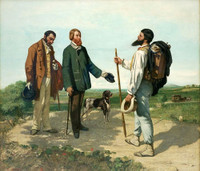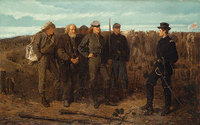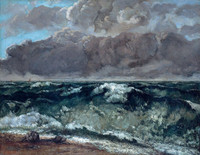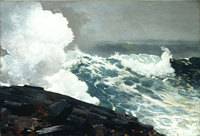The New Yorker‘s books blog, The Book Bench, asked me what I think of a new poll about American reading habits released today by Zogby International, and I’m afraid I think it’s not so great.
Implied life on Mars
Twenty-one hours ago, the space probe Phoenix landed on Mars, and NASA has already released some images. Looking at them, somewhat blearily, this morning, I felt almost frightened. This is what I would see if I were stranded on Mars, I realized, and the realization had uncanny force. Red dirt and rubble for miles and miles. I couldn’t figure out why the photos were so powerful. I’d looked at lots of pictures from the Mars Pathfinder and its sidekick, the Sojourner Rover. How come they had never hit me in the pit of my stomach?
Later in the day the answer came to me: the Phoenix photo (left) had been taken from a camera roughly as high off the ground as my eyes are. That was my subjective and retrospective impression, anyway, and double-checking just now, it seems to be the case. The Phoenix’s Surface Stereo Imager, which took this picture, sits on a mast that puts it “two meters above the ground, roughly the height of a tall person,” according to the NASA website. The mast for the Mars Pathfinder’s Imager, by contrast, only hoisted it about a meter off the ground. And the Rover snuffled along with a turtle’s-eye view. If I were a toddler, maybe the Pathfinder’s pictures would have a stronger effect on me, but as it is, the Phoenix is more likely to get under my skin.
This insight came to me on the subway, where I had idly noticed a grade-school-age girl watching an animated movie on her I-Pod while her parents, on either side of her, read a paper edition of the New York Times. Her tiny screen kept flickering, as the movie jump-cut from one viewing angle to another. I think that’s what made me realize that it was the viewing angle of the space probe that brought its picture home to me. The flickering also made me think of a 1929 movie I had tried to watch last week, a Maurice Chevalier vehicle called Love Parade, a crashing bore that I gave up on after an hour. The one thing I had liked about it was how primitive its cutting was: the camera was for the most part just planted in front of the actors, who sang and danced before it in takes that lasted minute upon leisurely minute. The implied viewer, after all, was a theatergoer, accustomed to sitting in his seat for hours. Who (I next wondered) is the implied viewer of a modern movie, with all its cuts and jumps? The viewpoint assembled from the multiple camera angles moves much faster than any of the actors—faster, in fact, than any single human being could move—so fast that the implied viewer of a contemporary movie can’t be an individual at all. It has to be a crowd, which is in more than one place at a time. You watch a modern movie as if your self were a group of people. No doubt film theorists figured this out long ago, but it was news to me, and a bit disturbing. Suddenly solitude on Mars seemed almost homey.
Parallels
Yesterday we went to the Gustave Courbet exhibit at the Metropolitan Museum of Art. It was the show’s last day, so it’s not very timely of me to blog about it. But I happened to notice a number of parallels between Courbet and another realist painter, Winslow Homer. (According to Google, real scholars have remarked on the parallels before; I’m just playing amateur here.) Homer was somewhat younger than Courbet and an American. Evidently he went to France just after the Civil War, and he would have encountered Courbet’s work then, but that’s too late, biographically speaking, to explain the parallel that I found most striking, that between Courbet’s The Meeting, or Bonjour, Monsieur Courbet (1854) and Homer’s Prisoners from the Front (1866), which Homer seems to have painted before he left America.
Left: Gustave Courbet, The Meeting, or Bonjour, Monsieur Courbet, 1854, Musée Fabre, Montpellier. Right: Winslow Homer, Prisoners from the Front, 1866, Metropolitan Museum of Art, New York.
Courbet painted himself as a virile young wanderer with backback, walking stick, and hat. (There seems to me, by the way, to be something Walt Whitman-esque in Courbet’s early portraits of himself in schlumpy hats, champing on provincial-looking pipes—something of the artist hamming it up as a proletariat, in the days when the revolutionary scent of 1848 still hunt in the air.) The bearded redhead saluting him is his patron, Alfred Bruyas, accompanied by a slouching servant. If Homer did have Courbet’s painting in mind, and perhaps he saw a fellow-artist’s study-sketch of it, or a lithographic reproduction, it’s intriguing that in the patron’s place stands an equally redheaded Confederate soldier, and that the Union soldier who captured him stands in the artist’s. (The superposition brings to mind Henry Ferris, the American painter-hero of William Dean Howells’s 1875 novel A Foregone Conclusion, who enlists in the Union Army at the end of the book.)
The other two parallels I noticed weren’t in composition but merely in subject matter and feeling-tone. First, the ocean:
Left: Gustave Courbet, The Wave, 1869, Staatliche Museen zu Berlin, Nationalgalerie. Right: Winslow Homer, The Northeaster, 1895, The Metropolitan Museum of Art.
Second, foxes in snow:
Left: Gustave Courbet, Fox in the Snow, 1860, Dallas Museum of Art. Right: Winslow Homer, Fox Hunt, 1893, Pennsylvania Academy of the Fine Arts.
Impediments
“The big question about Roderick Hudson,” a friend said to me, before I started reading it, “is, did Henry James have any idea how gay it was.” Now that I’ve finished, I agree that this is a good question.
I had read a fair number of James’s other novels before coming to Roderick Hudson, and in that light, what my friend refers to as its gayness is a bit of a surprise. One hears a lot about the alleged homosexuality of James, but in most of the novels of his that I’ve read, it’s so implicit in his subjectivity as to be beneath notice, unless you’re the sort of person who tags delicacy of perception or subtlety of expression as gay. True, it’s possible to see something not quite heterosexual in the valetudinarian, hands-off policy of Ralph Touchett, or in the refined collecting habits of any number of other characters, but the reader doesn’t sense any deformation in the material because of it. That is, if a character seems a tad gay, it’s perhaps because James wants you to understand that he is a tad gay. It’s plausible that Touchett might be, for example, leaving aside the question of whether he knows it about himself; one may entertain the possibility without having to imagine that James has lied to you about Touchett anywhere along the way. There don’t seem to be any substitutions or rearrangements; James doesn’t seem to try the Albertine strategy, for example, Proust’s trick of turning a man’s male beloved into a female character. The women seem to have been conceived of as women, not as men who have been transposed into women. Where he seems to have worked with material that in its original form involved homosexual desire, he omits but does not distort.
But that’s not the case in Roderick Hudson, and there’s something a little off about it, as a result. In the opening chapters, James drops hints that seem almost lurid. When Rowland Mallet, a well-meaning, somewhat purposeless, thirty-year-old heir, visits Cecilia, the sexy, ironic-voiced, twenty-eight-year-old widow who is his not-by-blood cousin, in Northampton, Massachusetts, she at one point apologizes for the town’s meager social resources by saying, “If I refused last night to show you a pretty girl, I can at least show you a pretty boy,” and then reveals a bronze statuette of a “naked youth drinking from a gourd . . . a loosened fillet of wild flowers about his head.” Rowland likes it an awful lot. It was sculpted, Cecilia reveals, by her friend Roderick Hudson, a twenty-four-year-old law student, who, when he and Rowland meet, explains that the cup in the statue is a symbol of “knowledge, pleasure, experience.” Rowland replies, “Well, he’s guzzling in earnest,” and soon decides that what he will do with his life is take Roderick, whom he considers a “beautiful, supple, restless, bright-eyed animal,” to Italy, so that he can study art and blossom into a sculptor.
And no one bats an eyelash—that’s the first thing that seems false. When, in a similar case, Mrs. Touchett takes Isabel Archer to England, there’s no whiff of scandal: the age difference is much greater, Mrs. Touchett is married, however unhappily, and the two women are related. But the motivation for Rowland to take Roderick abroad seems insufficient, unless one supposes that Rowland has a crush. James immediately quashes that supposition by concocting a female love interest for both Rowland and Roderick—in fact, the same female love interest. The reader is asked to believe that as a consequence of Rowland’s invitation, Roderick suddenly proposes marriage to his distant cousin and longtime housemate Mary Garland, whom Rowland just as suddenly discovers that he’s in love with. On second thought, Roderick’s abrupt proposal isn’t the false point—one can easily imagine that a heterosexual, somewhat egotistic young man, in the face of new and unknown risks, might suddenly grab for security at a woman he has long taken for granted—but Rowland’s abrupt tumble into love definitely is. Or rather, the notion that he is in fact in love is implausible. Where Mary is concerned, James’s narrative doesn’t allow us to see too clearly what’s in Rowland’s mind, but the most perspicuous emotion he seems to have is feeling sorry for her. He seems very badly to want to believe he’s in love with her, but that fish belongs to a different kettle.
In Venice, there’s another lurid touch. Faced with masterpieces by Titian and Veronese, Roderick briefly feels inadequate. Then he and Rowland hire a gondola.
Roderick lay back for a couple of hours watching a brown-breasted gondolier making superb muscular movements, in high relief, against the sky of the Adriatic, and at the end jerked himself up with a violence that nearly swamped the gondola, and declared that the only thing worth living for was to make a colossal bronze and set it aloft in the light of the public square.
The reader fans himself with alarm over such passages, but nothing really comes of them. James seems to have toyed with the notion that something in Roderick’s artistic sensibility might have responded to Rowland’s generosity, but he went no further than toying. That’s fine; there’s no real distortion here. Someone like Roderick probably wouldn’t have responded to someone like Rowland, in the way he might have responded to a gondolier. The trouble is with Mary Garland, and with the conceit, which James sticks to grimly until the end, of Rowland’s love for her. I ended up more or less convinced that James had effected a variation on the Albertine strategy with her. (Spoiler alert: Stop reading now if you don’t want to know how the novel ends.) In other words, I felt that James more or less consciously intended for Rowland’s supposed love for Mary to stand in for something he felt he couldn’t represent, namely, Rowland’s actual love for Roderick.
The conviction seems hard to avoid while reading Roderick and Rowland’s final confrontation. In it, Rowland offers Roderick money, which Roderick resists taking, out of what he calls “brute instinct.” He lashes out at the older man’s generosity, making a strange accusation: “Decidedly there are certain things you know nothing about.” Rowland: “These things—what are they?” Roderick: “They are women, principally, and what relates to women. Women for you, by what I can make out, mean nothing. You have no imagination—no sensibility, nothing to be touched!”
To the anachronistic gay reader, this seems promising. “You are incredibly ungrateful,” Rowland answers. “How do you know whether I have loved or suffered?” he continues, and then goes on to call Roderick an egotist. “You are selfish. . . . You regard other people only as they play into your own hands.” The anachronistic gay reader marvels: Is James headed for the éclaircissement that I think he’s headed for—that of an older gay man about to lose patience with a younger straight one who has taken his favors without returning his affections, and is the older gay man about to discover, to his chagrin, that love doesn’t go by tit-for-tat rules?
The two men continue their accusations and confessions. Roderick reaches the point of realizing that Rowland has been suffering at his hands. “I must have been hideous,” Roderick half-apologizes. “It has been a terrible mistake, then? . . . And all this time, you have been in love? Tell me the woman.”
Rowland felt an immense desire to give him a visible palpable pang. “His name is Roderick Hudson.”
Not, of course, though a rewrite is temptingly easy (“The surprise was great; Roderick coloured as he had never done. ‘Heaven forgive us!’ Rowland observed the ‘us’…”). In James’s novel, Rowland outs himself as a man in love with Roderick’s fiancée. Oh well. The revelation sends Roderick careening to his death, as such revelations generally do in melodrama, and the death doesn’t bring Rowland and Mary together, as such deaths generally don’t in crypto-gay fictions. But wouldn’t it be pretty to think so?
Try not to look appetizing
For obvious reasons, I’ve long had my eye on the domain name “calebcrain.com.” I didn’t feel any urgency, but it seemed better to own it than not to, if I had the chance. Until February of this year, it was owned by a woman in Texas, according to Whois, which reveals such things. My theory was that she bought it because she was friend or family to a young Christian musician from Texas who’s named, as it happens, Caleb Crain. As near as I can tell, he’s my only Google doppleganger over the age of twelve, and if he and I were to get out our respective family trees, I’ll bet we’d discover we’re related, since my family is from Texas as well. I figured he had as good a right to the name as I did, and I waited to see what he’d do with it, if it was indeed on his behalf that the woman had bought it. Nothing, as it happens. Shortly before the domain expired, I sent a note to the email address listed by Whois as its owner’s, because I had read that it was sometimes easier to negotiate transfers before a domain expired rather than after. The email bounced, however.
Domain names don’t expire quickly. Regulations require the registrars, who keep track of the ownership of domain names, to give owners time to have second thoughts. There seem in fact to be several intermediate phases of decay, which I don’t pretend to understand. All I know is that on May 9, the databanks at Whois listed the domain as in the status of “Pending Delete,” in a way that suggested it was then still in the hands of Melbourne IT, the company with whom the Texas woman had registered it. And on May 10, Whois said it was owned by a company called Domainsoftheworld.net, which owns between 2,500 and 3,000 domain names on any given day and advertises on its website that it sells domain names for the low, low price of $100,000.
Naturally, I freaked out. I went into research overdrive, and on behalf of anyone who might find themselves in a similar predicament, I’m going to share what I learned.
First, was it legal for these people to ask for $100,000 for the rights to my name? Not really. The practice is known as “cybersquatting,” and Congress banned it in 1999. Unfortunately, Congress made it a civil rather than a criminal offense; I would have had to hire a lawyer to right the wrong. (Internic, the entity that runs the internet, to the extent that anyone does, offers a domain name resolution procedure, but it applies only to trademarks, not to personal names, and it costs several thousand dollars.)
Okay, so I was powerless. Who were these guys? By various bits of Googling, I determined that Domainsoftheworld.net (whom I will henceforth call “Domains of the World,” because I can’t stand run-together brand names) shared a street address with a company called Snap Names, located in Portland, Oregon, which specializes in re-selling domain names. A lot of other dodgy sounding companies, with names like “Domains of the Day” and “Name Emperor,” shared the same address. It turns out that the re-selling of domain names is a big business. I figured it to be a shady one, but in fact Snap Names is a prominent company with a reputation to maintain; this I took to be a good sign. For years, more than half of Snap Names’s business came from raking up the domain names that the registrar Network Solutions deleted and trying to squeeze a little remaining profit out of them. Last year, however, the original owners of Snap Names sold the company to another domain name biggie, Oversee; some months later, perhaps miffed that the sale had taken place without their input, Network Solutions started giving its discarded domain names to a new partner, and Snap Names is said to be in trouble.
The fate of Snap Names, however, is neither here nor there to my story. As it happens, in fact, Whois reports today that the domain “domainsoftheworld.net” itself is registered through the company Enom, which is one of Snap Names’s big competitors. Whatever. I won’t even get into the patent application that Snap Names filed with the World Intellectual Property Organization for a way to find out about domain names whose deletion is pending “before the registry issues a public delete notification” and grab them before they’re publicly available. The larger point is, there are lots of very clever people who make their living by figuring out ways to take over domain names at the moment they expire, or even before that moment. I never had a chance.
What were they going to do with my poor name? Precious as it is to me, I did not think anyone was going to ransom it for $100,000. As a point of principle, I wasn’t going to pay them anything for it, and to the best of my knowledge, the only other adult named Caleb Crain had already passed. I pointed my browser toward the URL in question, and what I saw was a very plain, text-only webpage with links that seemed to point to topics that I had written about over the past half dozen years, along with links that were obviously just to the usual internet junk. Probably all the links, if you clicked on them, went to the usual internet junk. I did not click, but I got the idea. Domains of the World hoped that people searching for my name would arrive at their page and click on some of the terrible links, thereby earning them a tiny amount of cash. They weren’t really focused on me per se. They were doing this to lots of different domain names, more or less randomly, probably through an automated process. When they happened on domain names that brought in a reasonable amount of traffic, they kept them. The process is known as “domain tasting.”
A glimmer of hope: If my name seemed without value, they might let it go. Here, I think, my native paranoia stood me in good stead. Despite the intensity of my freak-out, I never typed “calebcrain.com” into the searchboxes provided on the webpages of Domains of the World, or of Snap Names, or of a third company, Logic Boxes, which seems to have provided some of the back-office logistics that made Domains of the World and Snap Names function. I was afraid to let anyone know I was interested, and I knew that these were the sort of people who collected such information. I may have been more paranoid than necessary; the thing about paranoia is, you never really know how much you need until you’ve failed to muster up enough of it.
I soon learned, from a site called Taste Reports, that every day Domains of the World deletes about as many domains as it registers—several hundred. (I even found in Taste Reports an entry for “calebcrain.com” listed under the date that my name was swallowed up, May 8—a date on which the deletion was still, as far as Whois and I knew, pending. Though Taste Reports was helpful in its revelations, I was consistent in my paranoia, and even on their page I never so much as let my mouse cursor hover over the link to my name.) My best bet seemed to be to hold very still and try to look as small and as unappetizing as possible for the next few days. Displeased with what it had swallowed, Domains of the World would then spit me out, the way the swamp creature of Dagobah spits out R2D2 in The Empire Strikes Back.
I would not be posting any of this, of course, if the domain name hadn’t been regurgitated. It happened this morning, and by midday tomorrow, if you type “calebcrain.com” into your browser you will end up at “steamthing.com.” As far as the strategy goes—don’t panic and stay paranoid—it worked for me, but I have no idea if it will work generally. Your monster may be paying closer attention, or may just be nastier.







